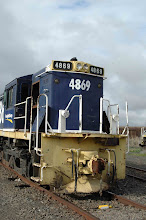Man have the last 6 months been busy! Due to work being so crazy lately it has obviously affected my modelling pursuits and as such the layout has suffered. Below is about the only progress that has been made due to my lack of spare time whilst at home.
I decided to get a bit more of my scenery completed.
This time it was a cutting through some stone.
The above stones were cast with plaster cast from Woodlands Scenics rock moulds.
After shaping the polystyrene, it was coated with plaster cloth.
Next the precast rocks were attached to the plaster cast with extra plaster.
Then they were painted flat black all over.
Then washed with a diluted grey, not as diluted as water but quite runny so it would only sit in the cracks.
This process was repeated several times untill I was happy with the result.
At this stage it has had some light brown dry brushed into areas to break up the colour a little.
The finished result.
Add a bit of dirt, some bushes, rocks and trees to complete the scene.
I got a bit excited and painted the backdrops. I was amazed how much difference painting the entire back scene in the room made the entire place light up!
Hopefully I can get in a bit of free time to attempt some clouds?














































































.jpg)






